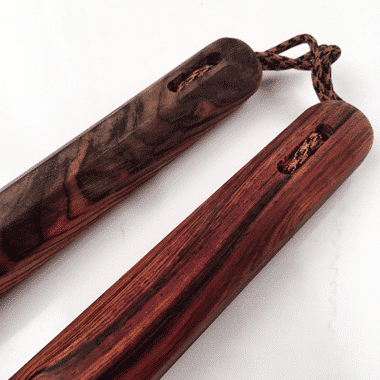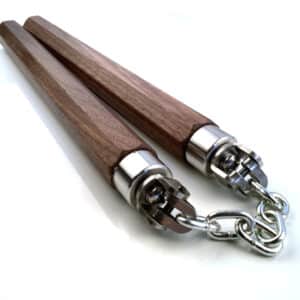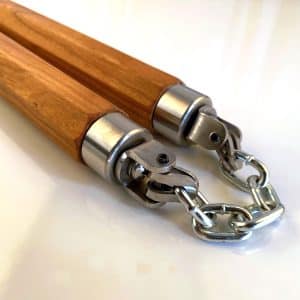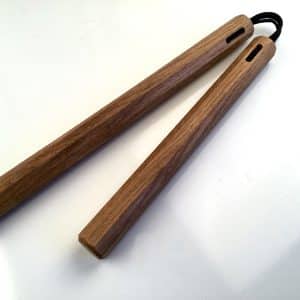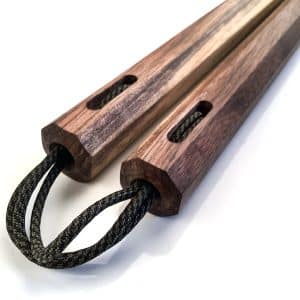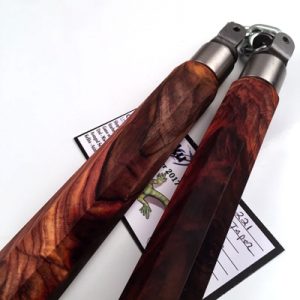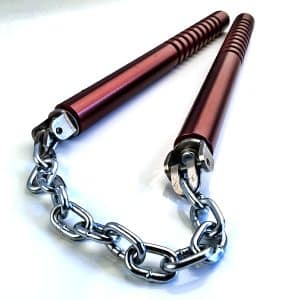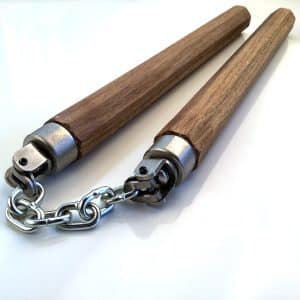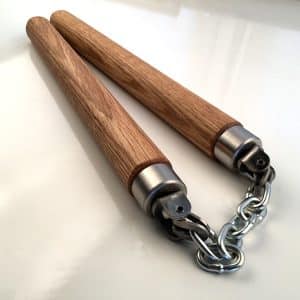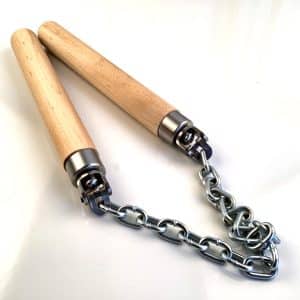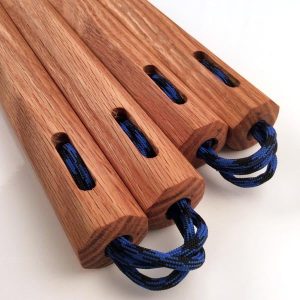Chuka Sticks
This site is best viewed on a tablet or computer to display all the different nunchaku that we offer. GO TO SHOP PAGE
The nunchaku (Japanese: ヌンチャク Hepburn: nunchaku, often “nunchuks“, “chainsticks“, “chuka sticks” or “karate sticks” in English) is a traditional Okinawan martial arts weapon consisting of two sticks connected at one end by a short chain or rope. The two sections of the weapon are commonly made out of wood, while the link is a cord or a metal chain. The nunchaku is most widely used in martial arts such as Okinawan kobudō and karate, and is used as a training weapon, since it allows the development of quicker hand movements and improves posture. Modern-day nunchaku can be made from metal, wood, plastic or fibreglass. Toy and replica versions made of polystyrene foam or plastic are also available. Possession of this weapon is illegal in some countries, except for use in professional martial art schools.
Straight Octagon Nunchaku
The exact origin of nunchaku is unclear. Allegedly adapted by Okinawan farmers from a non-weapon item, it was not a historically popular weapon because it was ineffective against the most widely used weapons of that time, and few historical techniques for its use still survive.
In modern times, nunchaku (Tabak-Toyok) were popularized by actor and martial artist Bruce Lee and his martial arts student Dan Inosanto, who introduced this weapon to the actor. Another popular association in modern times is the fictional character Michelangelo of the Teenage Mutant Ninja Turtles franchise. Organizations including the North American Nunchaku Association, World Amateur Nunchaku Organization, Fédération Internationale de Nunchaku de Combat et Artistique, World Nunchaku Association, and International Techdo Nunchaku Association teach the use of nunchaku as a contact sport.
The origin of the word nunchaku (ヌンチャク) is not known. One theory indicates it was derived from pronunciation of the Chinese characters 双截棍 (a type of traditional Chinese two section staff) in a Southern Fujian dialect of Chinese language (兩節棍 nng-chat-kun, pair(of)-linked-sticks). Another derives from the definition of “nun” as “twin”.
Another name for this weapon is “nûchiku”(ヌウチク).
In the English language, nunchaku are often referred to as “nunchuks”.
Formal Styles
The nunchaku is most commonly used in Okinawan kobudō and karate, but it is also used in eskrima (more accurately, the Tabak-Toyok, a similar though distinct Philippine weapon, is used, as opposed to the Okinawan nunchaku), and in Korean hapkido. Its application is different in each style. The traditional Okinawan forms use the sticks primarily to grip and lock. Filipino martial artists use it much the same way they would wield a stick—striking is given precedence. Korean systems combine offensive and defensive moves, so both locks and strikes are taught. Nunchaku is often the first weapon wielded by a student, to teach self-restraint and posture, as the weapon is liable to hit the wielder more than the opponent if not used properly.
The Nunchaku is usually wielded in one hand, but it can also be paired. It can be whirled around, using its hardened handles for blunt force, as well as wrapping its chain around an attacking weapon to immobilize or disarm an opponent. Nunchaku training has been noted to increase hand speed, improve posture, and condition the hands of the practitioner. Therefore, it makes a useful training weapon.
There are some disciplines that combine nunchaku with unarmed techniques:
- Mouhébong Taekwondo combines Korean nunchaku with taekwondo.
- Nunch-Boxing combines nunchaku with kicking and punching techniques. Nunch-Boxing itself is part of the broader discipline Nenbushi.
- Nunchaku en savate combines savate techniques with the nunchaku.
Free Styles
Freestyle nunchaku is a modern style of performance art using nunchaku as a visual tool, rather than as a weapon. With the growing prevalence of the Internet, the availability of nunchaku has greatly increased. In combination with the popularity of other video sharing sites, many people have become interested in learning how to use the weapons for freestyle displays. Freestyle is one discipline of competition held by the World Nunchaku Association. Some modern martial arts teach the use of nunchaku, as it may help students improve their reflexes, hand control, and other skills.
Sporting Associations
Since the 1980s, there have been various international sporting associations that organize the use of nunchaku as a contact sport. Current associations usually hold “semi-contact” fights, where severe strikes are prohibited, as opposed to “contact” fights. “Full-Nunch” matches, on the other hand, are limitation-free on the severity of strikes and knockout is permissible.
- North American Nunchaku Association (NANA): Founded in 2003 in California by Sensei Chris Pellitteri, NANA teaches all aspects of the nunchaku, traditional and free-style, single and double.
- World Amateur Nunchaku Organization (WANO): Founded by Pascal Verhille in France in 1988.
- Fédération Internationale de Nunchaku de Combat et Artistique (FINCA): Founded by Raphaël Schmitz in France in 1992 as a merger of disbanded associations WANO and FFNS (Fédération Française de Nunchaku Sportif). Its current name is Fédération Internationale de Nunchaku, Combat complet et Arts martiaux modernes et affinitaires (FINCA). A fight with FINCA rules lasts two rounds of two minutes. There is no need for changing either the nunchaku branch or the hand before hitting, just a correct recuperation. There are no stops during the fight, except for loss, lifting, or penalties.
- World Safety Nunchaku Organization (WSNO) : Safety Nunchaku Grandmaster Soshihan S. Kothandan, India’s Senior most Shito-ryu Karate exponent who got trained under many world level renowned Grand masters in Martial Arts, has gained rich technical expertise in that domain by his passion towards the Art, and he has achieved many milestones in Karate field particularly in Shito-ryu Karate from the past 46 years. He started researching in Safety Nunchaku from 1991 onward. He founded and presented Safety Nunchaku for the first time in front of the general public and Honorable Ministers of Tamil Nadu, India on 28.08.2005. On this day, Safety Nunchaku, Kata, Team Kata, Kumite, Team Kumite, Own style, Stand Target, Moving Target and other new techniques were demonstrated. This research is being continued by means of meeting experts from different parts of the world and sharing their view on Safety Nunchaku as a game and as a Martial art. Finally, 02-08-2015 he had introduced Safety Nunchaku in front of VIP’s, and General Public & released website (www.worldsafetynunchaku.org), demonstrated KATA’s and gave Black Belt to 1st Batch who got training more than two years during his research period. With his vast knowledge, experience and hard work he has introduced and dedicated first time in the Martial Art field “World Standard 16 unique Katas” in the field of Safety Nunchaku. If a person know the proper names of the techniques, correct method of practicing such techniques and most important is where to apply such techniques and what circumstance to apply those techniques then he will do very well in real life under critical situations where his safety is prime concern. By keeping those very important facts in mind, he has framed Katas in Safety Nunchaku in a simple and elegant way where a common people can get into interest to practice and understand the nuances of each techniques.He has also followed some unique methodology to name “World Standard 16 Unique KATAs” in Safety Nunchaku. In general Japanese, when they design a Kata, they gave their names or their master names. But, In Safety Nunchaku, Grandmaster Soshihan S.Kothandan had given names Single chaku “World Standard 16 Unique Katas ” to the patriots-freedom fighters, who made the country to proud globally, People who made proud India in Martial Arts and aid citizens to spread the Art throughout the country and People who supported, encouraged Soshihan in the Karate domain and considered his growth and success as a growth of Martial Art. Safety Nunchaku Grandmaster Soshihan S. Kothandan to insist that fact to future generation to remember those legends in the Name of KATA in near future. Also he categorized the above Unique katas as Origin Katas (4), Fundamental Katas (4) & Superior Katas (8). He also manufactured with foam and foam rubber Safety Nunchaku cheaper, different colors and different sizes to use all ages of public.
- World Nunchaku Association (WNA): Founded by Milco Lambrecht in the Netherlands in 1996.] WNA uses yellow and black plastic weight-balanced training nunchaku and protective headgear. They have their own belt color system, in which participants earn color stripes on the belt, instead of fully colored belts. One side of the belt is yellow and the other black, so that in a competition, opponents may be distinguished by the visible side of the belt. WNA fight rules correspond to the kumite subsection of Nunchaku-do discipline. It is a two-minutes “touch fight,” in which technical abilities are very important. After each scored point, the fight stops and the fighters take back their starting position.
- International Techdo Nunchaku Association (ITNA): Founded by Daniel Althaus in Switzerland in 2006. ITNA rules fights last two rounds lasting 2:30. There are no stops during the round, except for loss, lifting, or penalties. Between two strikes, the fighter has to change hand and nunchaku branch before hitting again, except if he blocks.
Legality
Possession of nunchaku is illegal, or the nunchaku is defined as weapon in a number of countries, including Norway, Canada, Russia, Poland, Chile, and Spain. In Germany, nunchaku have been illegal since April 2006, when they were declared a strangling weapon.
In the United Kingdom, it was legal for anyone over the age of 18 to buy and possess nunchaku for many years, although public possession is not allowed unless transporting between places of training or private addresses. However, following a case brought by Strathclyde Police and the procurator fiscal heard at Glasgow Sheriff Court on 10 February 2010, a sheriff ruled that nunchaku fell into the category of a “prohibited weapon,” as defined by the Criminal Justice Act 1988. The nunchaku in question were the fixed length (non-telescopic) wooden type handles, which the sheriff judged to be contrary to current legislation.
The usage of nunchaku was, in the 1990s, censored from UK rebroadcasts of American children’s TV shows such as Teenage Mutant Ninja Turtles cartoons and films. The UK version of the Soul Blade video game was also edited, replacing the character Li Long‘s nunchaku with a three-sectioned staff. In Hong Kong, it is illegal to possess metal or wooden nunchaku connected by a chain, though one can obtain a license from the police as a martial arts instructor, and rubber nunchaku are still allowed. Possession of nunchaku in mainland China is legal.
Legality in Australia is determined by individual state laws. In New South Wales, the weapon is on the restricted weapons list and, thus, can only be owned with a permit.
Legality in the United States varies at the state level. For example, personal possession of nunchaku is illegal in New York, Arizona, and California but in other states, possession has not been criminalized. California has made exceptions for professional martial arts schools and practitioners to use the nunchaku.
In New York, attorney Jim Maloney has brought a federal constitutional challenge to the statutes that criminalize simple in-home possession for peaceful use in martial-arts practice or legal home defense. The court dismissed Maloney’s Second Amendment claim based on prior case law that the Second Amendment applied only to federal action, and this decision was affirmed by the United States Court of Appeals for the Second Circuit. However, on June 29, 2010, the U.S. Supreme Court granted a writ of certiorari, vacated the decision of the Second Circuit, and sent it back for “further consideration”. It took this action in light of its decision in McDonald v. Chicago, which held that the right of an individual to “keep and bear arms” protected by the Second Amendment is made applicable to the states by the Due Process Clause of the Fourteenth Amendment.[36]
Law Enforcement Use
In 2015, police in the town of Anderson, California have been trained and deployed to use nunchaku as a form of non-lethal force. They were selected because of their utility as both a striking weapon and a control tool.
Nunchaku have been employed by American police for decades, especially after the popular Bruce Lee movies of the 1970’s, but tasers have since become the preferred non-lethal weapon for most departments.

